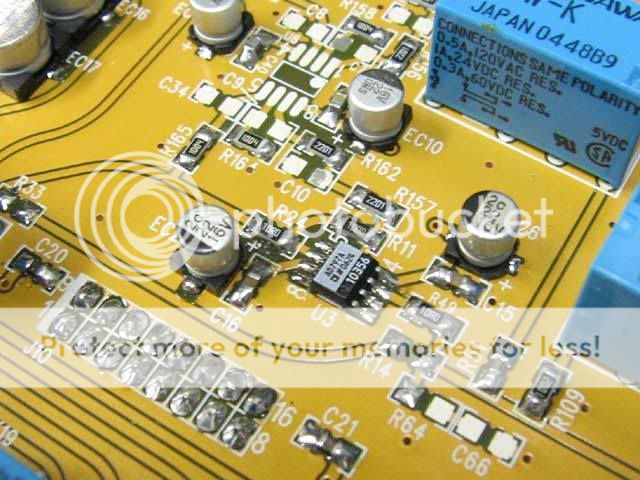AD797 does need special care. 100R isolation resistor into inverting input is needed, and feedback lead cap should be less than 30pF. Datasheet have mentioned that.
THS4031 have similar requirement, though it's not writen in the datasheet.

THS4031 have similar requirement, though it's not writen in the datasheet.

An idea was to hear what Scott Wurcer has to say since he has designed the AD797. Persnally I would avoid the opamp for inuty gain due to the restless phase behaviour at 0 dB gain.
HiFiNutNut said:Juma, would you mind sharing on how to properly implement it?
This worked great for me:
http://www.diyaudio.com/forums/attachment.php?s=&postid=980927&stamp=1155331765
A successful application:
Attachments
Hi Guys,
a newbie here. Just wanted to say hello. I saw the comments on amplifiers. FYI, there is a really nice and inexpensive op amp by NJR model NJM4580. It's very fast, extremely low distortion and reasonable power drain. I've designed it into many successful products.
a newbie here. Just wanted to say hello. I saw the comments on amplifiers. FYI, there is a really nice and inexpensive op amp by NJR model NJM4580. It's very fast, extremely low distortion and reasonable power drain. I've designed it into many successful products.
Yes, it was designed for Audio. You will find in many Pro Audio devices because of it's price/performance. The last design I did with it, the Audio Precision Portable One, could not measure THD or IMD as it was below it's limits. While that doesn't always make a good sounding audio device, I find them to sound very good, with a very good audio slew rate.
Can AD797 be used for low pass filters having cutoff 10Hz and gain greater than 10?
Please help...
Please help...
Yes, but what are you going to use it for?Can AD797 be used for low pass filters having cutoff 10Hz and gain greater than 10?
Please help...
I need to design a filter having large gain and very less settling time.
Have you checked AD797, Is it stable in high gain applications?
Have you checked AD797, Is it stable in high gain applications?
I don't know if this is the right threat to ask, but does anyone know if there's an alternative to the recently discontinued high output/low distortion LME49600? (because a buffer is just an unity gain op-amp)
I suspect not. 😀
I know, I know, it's a dull way to look at things, but wouldn't it be useful if, in subjective evaluation, people stopped talking about a box of gain "sounding good" or "sounding bad," but instead talked about whether or not the output sounded like the input?
How do you know how the "input" sounds??
Go to the concert hall, listen to the music and compare later ? 🙂
Forget about "sound", I guess we can only measure whatever is measurable and compare numbers.
...AD797, Is it stable in high gain applications?
Wrong question. The question is: is it stable at LOW gain applications.
Opamps get more stable at higher gains, worse at lower gains.
That is why datasheets sometimes specify a minimum gain for stability.
jan
Yes, it was designed for Audio. You will find in many Pro Audio devices because of it's price/performance. The last design I did with it, the Audio Precision Portable One, could not measure THD or IMD as it was below it's limits. While that doesn't always make a good sounding audio device, I find them to sound very good, with a very good audio slew rate.
Did you design for AP?
Jan
I don't know if this is the right threat to ask, but does anyone know if there's an alternative to the recently discontinued high output/low distortion LME49600? (because a buffer is just an unity gain op-amp)
Some people use/prefer the BUF634.
http://www.ti.com/lit/ds/symlink/buf634.pdf
audio line or headphone driving I like CFA op amps designed for a/dsl drivers - to use them as unity gain buffers in a composite amp you do need to size the CFA feedback R for unity gain stable operation
and most fast devices will need series output Z to be happy with the C load of cables
and most fast devices will need series output Z to be happy with the C load of cables
Last edited:
audio line or headphone driving I like CFA op amps designed for a/dsl drivers - to use them as unity gain buffers in a composite amp you do need to size the CFA feedback R for unity gain stable operation
Wouldn't it be so much easier to state you prefer the TPA6120 and recommend what value resistors(if different from the datasheet) to use around it, or show an example of a circuit that you're referring to?🙄
Some CFA op-amps, such as the AD811 for example, do not sound good even when incorporated inside the feedback loop of another op-amp like in the old Jung circuit.
Been there and tried that years ago.
The TPA6120 sounds pretty good...certainly better than the "sterile" sounding 49600/BUF634, but is much more difficult to implement than standard DIP-8 op-amps.
^ How do any of these opamps have much of a sound outside of their circuit implementation? Within a composite, they all have silly low distortion potential and (ostensibly) enough drive power for most any reasonable headphone.
How can a 10Hz low pass filter have any sound?for low pass filters having cutoff 10Hz
- Status
- Not open for further replies.
- Home
- Amplifiers
- Solid State
- opamps used for unity gain
